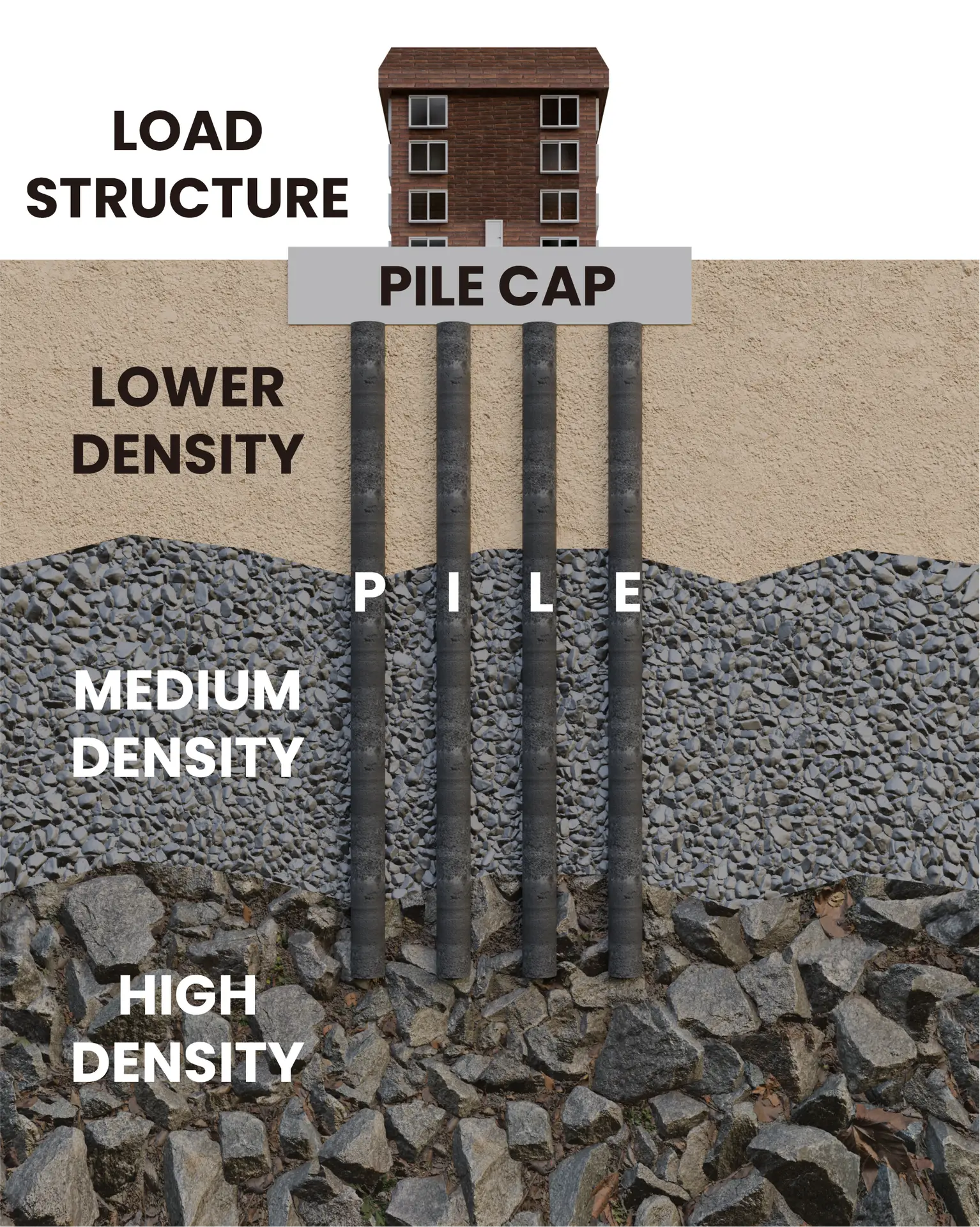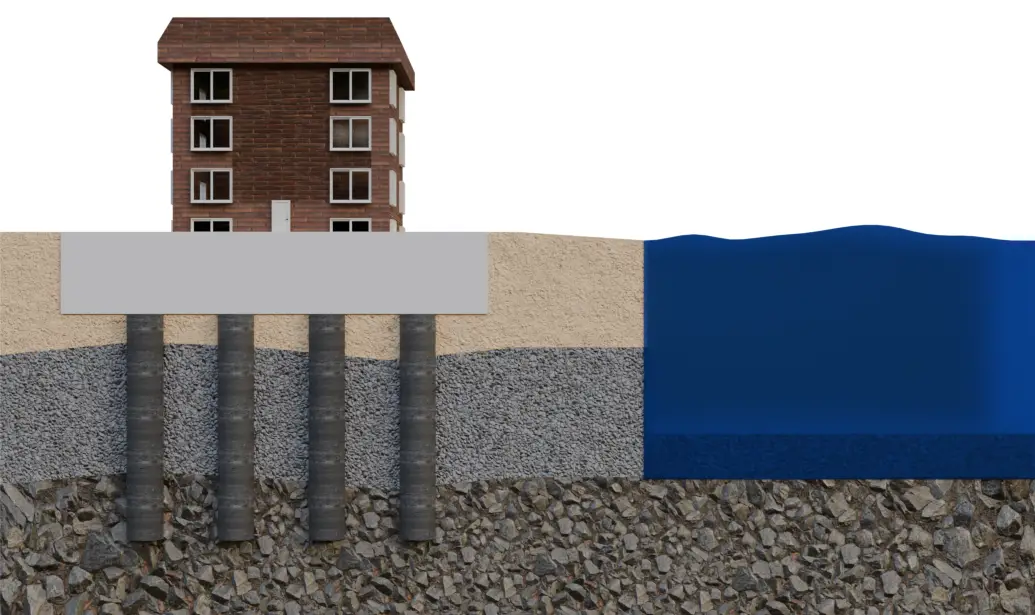What is Piling?
Deep foundation
In construction deep foundations is a method where long cylindrical supports made of wood, concrete or steel are driven into the ground. In this technique, long cylindrical piles are driven deep into the ground to create a firm, stable layer of soil at the construction site in situations such as weak ground or heavy building loads. In short, it can be thought of as the process of creating the perfect foundation for new construction.
This allows a stable structure to be built as the load of the building is spread over several installed piles.
When Should This Technique Be Used?
Around Water
Coastal or riverine sites may require this method to mitigate flooding risks and provide a stable foundation despite rising water levels.
For Uneven or Heavy Loads
For example, if there is a heavy object such as a certain equipment in a certain part of the building structure, the weight of the building is not evenly distributed and the load is concentrated on one side. In this case, the foundation can distribute the load evenly to prevent settlement or deformation of the ground.
Low-Density Soil Conditions
If the soil at the site is of low density, it can be easily compacted. In this case, piles can be installed up to the high density soil to ensure the stability of the building.
When soil moisture can cause problems
If there is groundwater, drainage systems or canals around the building, it may be difficult to keep the ground dry or the foundation may be weakened. Pile foundations can be used to overcome this situation.
Types of piles
Piles are made from a variety of materials, such as timber, concrete and steel, rather than just one type.
Because every site is different in terms of soil density, characteristics and external factors, they are categorised to ensure they are installed in the right place.
Concrete piles:
Precast concrete piles: These are piles prefabricated from concrete to the weight and size appropriate for the construction environment and transported to site as required.
Because of the nature of concrete, it is resistant to deformation such as cracking and breaking under impact, and because prefabricated piles can be installed under water, they have a wide range of applications. In addition, the prefabrication method has the advantage of speeding up the work, as it is possible to prefabricate the piles before construction starts.
However, it is important to know the exact length or size of the pile for the site in advance and, as the piles are large and heavy, it is important to prevent damage during transport.
Precast concrete piles can be manufactured in square, round and octagonal shapes.
Cast-in-place concrete piles:
The use of concrete as the material is the same as for precast concrete piles, but cast-in-place piles are made at the same time as the foundation is constructed by drilling a hole in the ground where the piles are to be placed, then pouring concrete into the hole and curing it.
This method allows the length of the pile to be adjusted to suit the site, as it is manufactured on site.
The number of piles can also be adjusted to suit site conditions.
However, the strength and quality can be slightly lower than with prefabrication, so it is important to manage the site carefully and continually monitor the production process.
Steel piles:
Capable of withstanding large loads, steel piles are mainly used for large structures, and steel piles can support weights of up to approximately 100 tonnes per pile.
Timber piles:
Timber piles are Installed in dense soils below the water table.
They are used in temporary structures and structures with medium loads.
Considerations for Successful Piling
Geotechnical Investigation
Detailed site investigation is essential. Soil borings, laboratory tests, and field penetration tests (e.g., SPT, CPT) help determine the soil profile, bearing capacity, and groundwater conditions.
Accurate data informs pile type selection, design load calculations, and selection of driving equipment.
Design and Load Calculations
Structural engineers collaborate with geotechnical experts to determine the required pile diameter, length, material, and spacing.
Designs must account for axial load, lateral load, seismic forces, potential uplift, and other project-specific demands.
Environmental and Noise Constraints
Urban environments may require low-noise or low-vibration solutions (e.g., hydraulic vibratory hammers, bored piles) to avoid disrupting nearby structures or populations.
Projects near protected habitats or sensitive ecosystems often demand additional mitigation measures to minimize environmental impact.
Quality Control
During and after installation, load tests (static load tests, dynamic load tests) verify that piles meet design performance criteria.
Non-destructive testing (e.g., integrity testing) checks for any potential defects, such as cracks or voids within the pile.
Maintenance and Monitoring
While piles themselves are generally permanent, structures built on piled foundations may require periodic inspection, especially in regions with seismic activity or significant seasonal groundwater fluctuations.
Monitoring instruments can detect subtle movements or changes in load distribution, allowing timely intervention if needed.
What do you use to install files?
Ideal for precise pile-driving in soils where controlled vibration and frequency adjustment are crucial. They generate oscillations that help overcome soil resistance, effectively driving or extracting piles.
Traditional pilie hammers that repeatedly strike the pile head to drive it into the ground. While highly effective, they produce more noise and vibration compared to vibratory systems.
Used in bored piling, these drills remove soil to create a hole for concrete and reinforcement. They can be continuous flight augers (CFA) or sectional augers, depending on project constraints


